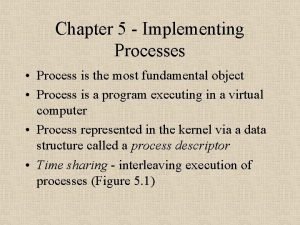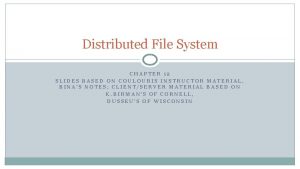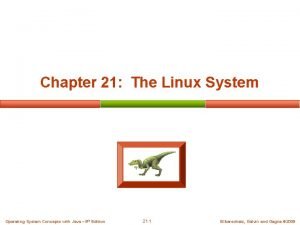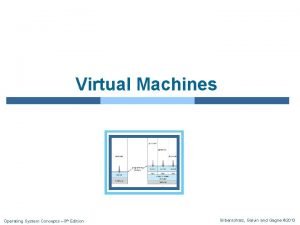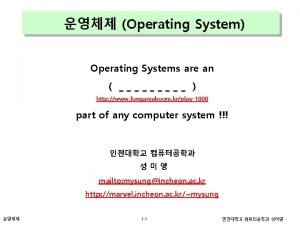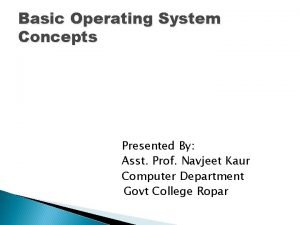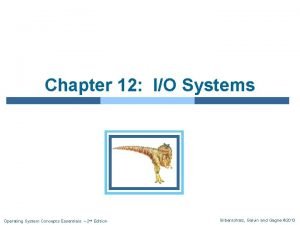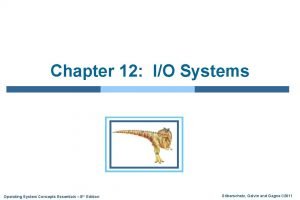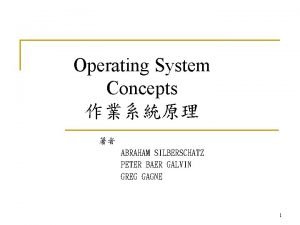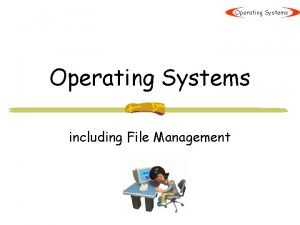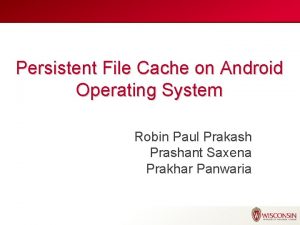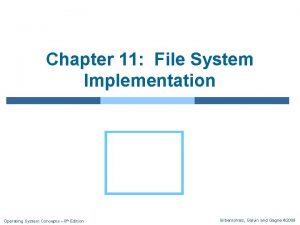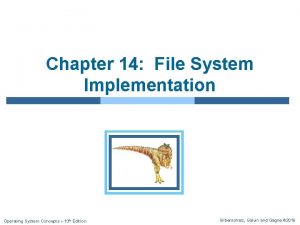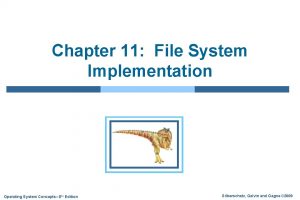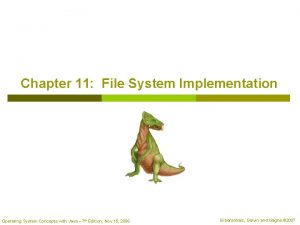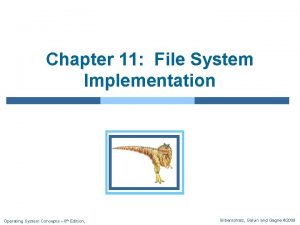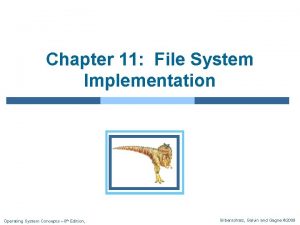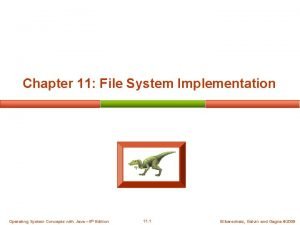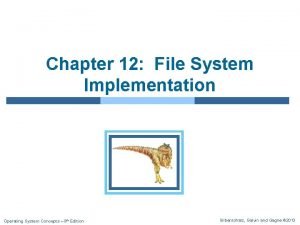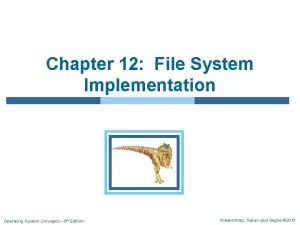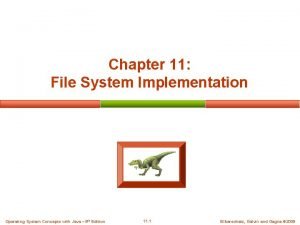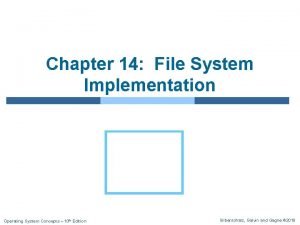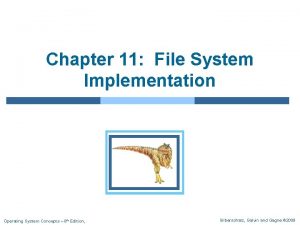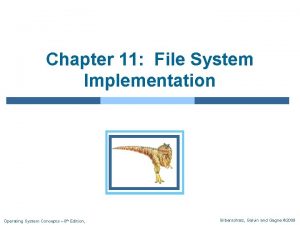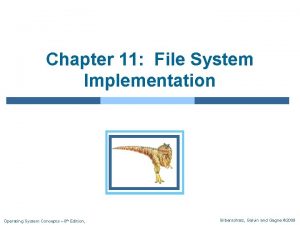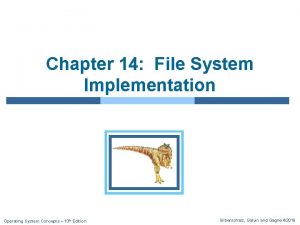Chapter 11 File System Implementation Operating System Concepts



















![Free-Space Management n Bit vector (n blocks) 0 1 2 n-1 ��� … bit[i] Free-Space Management n Bit vector (n blocks) 0 1 2 n-1 ��� … bit[i]](https://slidetodoc.com/presentation_image/db9687cc9e56617a691980b57645b7c6/image-20.jpg)


- Slides: 22

Chapter 11: File System Implementation Operating System Concepts – 8 th Edition, Silberschatz, Galvin and Gagne © 2009

Chapter 11: File System Implementation n File-System Structure n File-System Implementation n Directory Implementation n Allocation Methods n Free-Space Management n Efficiency and Performance n Recovery n NFS n Example: WAFL File System Operating System Concepts – 8 th Edition 11. 2 Silberschatz, Galvin and Gagne © 2009

Objectives n To describe the details of implementing local file systems and directory structures n To describe the implementation of remote file systems n To discuss block allocation and free-block algorithms and trade-offs Operating System Concepts – 8 th Edition 11. 3 Silberschatz, Galvin and Gagne © 2009

Layered File System Operating System Concepts – 8 th Edition 11. 4 Silberschatz, Galvin and Gagne © 2009

File-System Implementation n Boot control block contains info needed by system to boot OS from that volume n Volume control block contains volume details n Directory structure organizes the files n Per-file File Control Block (FCB) contains many details about the file Operating System Concepts – 8 th Edition 11. 5 Silberschatz, Galvin and Gagne © 2009

A Typical File Control Block Operating System Concepts – 8 th Edition 11. 6 Silberschatz, Galvin and Gagne © 2009

In-Memory File System Structures Operating System Concepts – 8 th Edition 11. 7 Silberschatz, Galvin and Gagne © 2009

Virtual File Systems n Virtual File Systems (VFS) provide an object-oriented way of implementing file systems. n VFS allows the same system call interface (the API) to be used for different types of file systems. n The API is to the VFS interface, rather than any specific type of file system. Operating System Concepts – 8 th Edition 11. 8 Silberschatz, Galvin and Gagne © 2009

Schematic View of Virtual File System Operating System Concepts – 8 th Edition 11. 9 Silberschatz, Galvin and Gagne © 2009

Directory Implementation n Linear list of file names with pointer to the data blocks. l simple to program l time-consuming to execute n Hash Table – linear list with hash data structure. l decreases directory search time l collisions – situations where two file names hash to the same location l fixed size Operating System Concepts – 8 th Edition 11. 10 Silberschatz, Galvin and Gagne © 2009

Allocation Methods n An allocation method refers to how disk blocks are allocated for files: n Contiguous allocation n Linked allocation n Indexed allocation Operating System Concepts – 8 th Edition 11. 11 Silberschatz, Galvin and Gagne © 2009

Contiguous Allocation of Disk Space Operating System Concepts – 8 th Edition 11. 12 Silberschatz, Galvin and Gagne © 2009

Linked Allocation n Each file is a linked list of disk blocks: blocks may be scattered anywhere on the disk. block Operating System Concepts – 8 th Edition = pointer 11. 13 Silberschatz, Galvin and Gagne © 2009

Linked Allocation Operating System Concepts – 8 th Edition 11. 14 Silberschatz, Galvin and Gagne © 2009

Linked Allocation (Cont. ) n Simple – need only starting address n Free-space management system – no waste of space n No random access File-allocation table (FAT) – disk-space allocation used by MS-DOS and OS/2. Operating System Concepts – 8 th Edition 11. 15 Silberschatz, Galvin and Gagne © 2009

File-Allocation Table Operating System Concepts – 8 th Edition 11. 16 Silberschatz, Galvin and Gagne © 2009

Indexed Allocation n Brings all pointers together into the index block n Logical view index table Operating System Concepts – 8 th Edition 11. 17 Silberschatz, Galvin and Gagne © 2009

Example of Indexed Allocation Operating System Concepts – 8 th Edition 11. 18 Silberschatz, Galvin and Gagne © 2009

Indexed Allocation (Cont. ) n Need index table n Random access n Dynamic access without external fragmentation, but have overhead of index block Operating System Concepts – 8 th Edition 11. 19 Silberschatz, Galvin and Gagne © 2009
![FreeSpace Management n Bit vector n blocks 0 1 2 n1 biti Free-Space Management n Bit vector (n blocks) 0 1 2 n-1 ��� … bit[i]](https://slidetodoc.com/presentation_image/db9687cc9e56617a691980b57645b7c6/image-20.jpg)
Free-Space Management n Bit vector (n blocks) 0 1 2 n-1 ��� … bit[i] = 0 block[i] free 1 block[i] occupied Block number calculation (number of bits per word) * (number of 0 -value words) + offset of first 1 bit Operating System Concepts – 8 th Edition 11. 20 Silberschatz, Galvin and Gagne © 2009

Free-Space Management (Cont. ) n Bit map requires extra space l Example: block size = 212 bytes disk size = 230 bytes (1 gigabyte) n = 230/212 = 218 bits (or 32 K bytes) n Easy to get contiguous files n Linked list (free list) l Cannot get contiguous space easily l No waste of space Operating System Concepts – 8 th Edition 11. 21 Silberschatz, Galvin and Gagne © 2009

Linked Free Space List on Disk Operating System Concepts – 8 th Edition 11. 22 Silberschatz, Galvin and Gagne © 2009
 File-file yang dibuat oleh user pada jenis file di linux
File-file yang dibuat oleh user pada jenis file di linux Operating system concepts chapter 8 solutions
Operating system concepts chapter 8 solutions Operating system concepts chapter 5 solutions
Operating system concepts chapter 5 solutions Operating system concepts chapter 5 solutions
Operating system concepts chapter 5 solutions File system in operating system
File system in operating system Ufs4.0
Ufs4.0 File system in operating system
File system in operating system Implementation of process in operating system
Implementation of process in operating system Distributed file system notes
Distributed file system notes Operating system concepts, 10th edition
Operating system concepts, 10th edition Linux operating system concepts
Linux operating system concepts Operating system concepts with java
Operating system concepts with java Operating system concepts 6th edition
Operating system concepts 6th edition Type 0 hypervisor
Type 0 hypervisor Realtime operating system
Realtime operating system Operating system concepts 9판 한국어판
Operating system concepts 9판 한국어판 Basic operating system concepts
Basic operating system concepts Operating system concepts 11th
Operating system concepts 11th Operating system concepts essentials
Operating system concepts essentials Operating system concepts essentials
Operating system concepts essentials Abraham silberschatz
Abraham silberschatz File management in os
File management in os File management in android operating system
File management in android operating system







